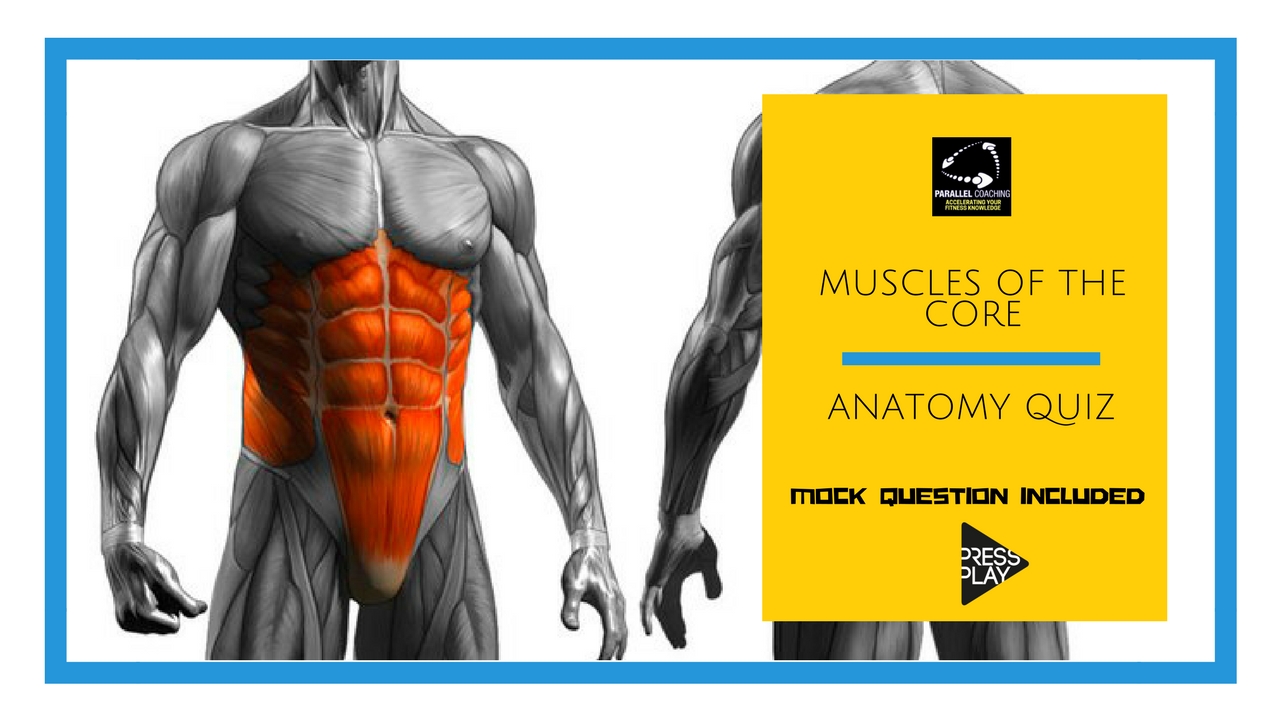In this blog, I am going to explain the muscles of the core,
- The three layers of the core,
- The inner core unit
- Key terms to remember
You need to know this for 2 reasons:
1) It WILL be in your level 2 and 3 Anatomy exams,
2) Without knowing this, you won’t be able to plan effectively for a client… which means the client is less likely to get their goal!
Pretty important, ah?
and there is an anatomy quiz to test your knowledge too.
Learning Point 1: The Three Layers
Most people think the core is all about the muscles they can see, but there are actually 3 layers of muscles of the core.
- The deepest layer is made of position sense muscles and make small movements around the spine whilst we do large movements with other muscles
- The middle layer is the inner core unit – these are really important muscles for stability, injury prevention and good posture * You need to know about these for your Level 3 anatomy quiz
- The outside layer is made of superficial muscles, these include the Rectus Abdominus and the Obliques.
Learning Point 2: The inner core unit
The inner core unit is comprised of four key muscles, which you need to know about for your level 3 anatomy and physiology exam.
These muscles include:
- The Diaphragm
- The Pelvic Floor
- The Multifidus
- The Tranversus Abdominus (TVA)
The Inner core unit is key for stability and protecting our spine, ligaments and intervertebral discs.
When the muscles contract they tighten the cylinder which creates a firm column throughout the torso and relieves pressure from the spine itself. This is called Intra Abdominal Pressure, and pressure is increased by activating the core. An activated core is the same firm “tensed” feeling that you get when you cough or sneeze; the TVA tightens and pulls in, the pelvic floor tightens and the diaphragm contracts to create this hard protective cylinder.
Top Tip: Know Your Terminology
Make sure you are aware of the following wording, in preparation for your anatomy quiz questions
- Superior = Upper most = Diaphragm
- Inferior = Lowest = Pelvic Floor
- Posterior = Furthest Back = Multifidus
- Anterior = Furthest Forward = TVA
Learning Point 3: The Six Pack
The Rectus Andominus is the official name for the six-pack muscles, and it is a superficial muscle. It is not part of the Inner Core Unit. This muscle is responsible for flexion of the spine, and therefore we use it during exercises like ab crunches.
Test Your Knowledge – Anatomy Quiz Questions:
Now you know about the muscles of the core, let’s test your knowledge. Simply answer the following questions, place your answer in the comments below and then check your answers below:
Q1: Which of the following forms the inferior aspect of the inner core unit?
A. Erector Spinae
B. Diaphragm
C. External Obliques
D. Pelvic Floor
Q2. Which of the following is NOT part of the Inner Core Unit?
A. Tranversus Abdominus
B. Rectus Abdominus
C. Pelvic Floor
D. Diaphragm
Q3. Which exercise would be most effective for training Intra Abdominal Pressure?
A. Plank
B. Full Sit Ups
C. Back Extensions
D. Bicycle Kicks
What’s the CORRECT answer?
Answers to the mock questions are :
Question 1= D, Question 2 = B, Question 3 = A
If you want more mock questions like this, then you can download more Free Mock Questions: DOWNLOAD NOW
Need More Help with your Level 3 Anatomy Revision?
For Trainee FITPROS Taking Their L3 Anatomy & Physiology Exam.
Learn, Revise & Pass Your Level 3 Anatomy & Physiology Exam In Under 10-hours
(Without Having To Spend Hours Revising Or Feeling Overwhelmed)
If you want to get your revision structured, learn everything you need to know, and feel confident on exam day, then click the link below:

Dedicated to More
Hayley “Muscles of the Core” Bergman
Parallel Coaching
P.S. You can also find us on the following platforms:
Instagram: Follow Now
Facebook: Like Our Page
Twitter: Tweet Us
YouTube: Subscribe Here
More Muscles Blogs: HERE

